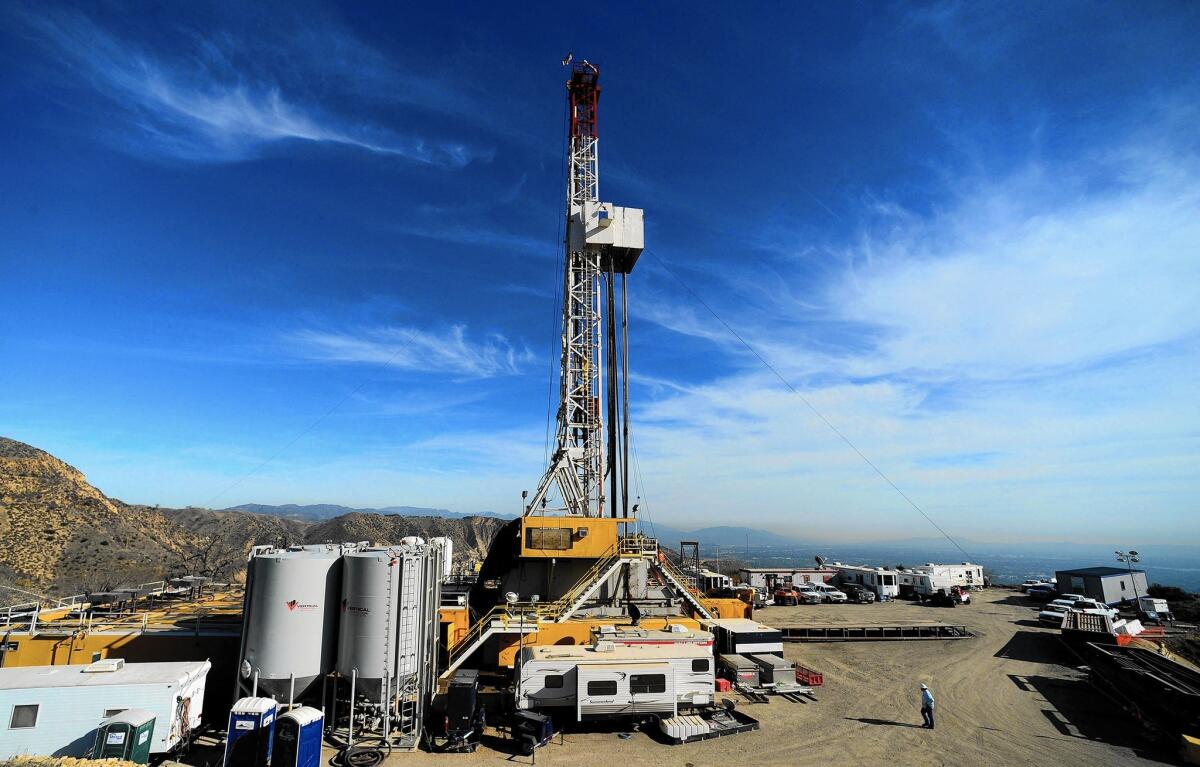229 leaks found in state’s underground gas storage facilities, most considered minor

- Share via
Leaks are common in California’s natural gas storage fields and are often left untreated for months, according to a survey taken after the massive leak in Aliso Canyon.
The survey of the state’s 12 storage fields found 229 faulty valves, flanges and leaky wellheads and a 230th leak at an abandoned well. Most leaks were minor. Eight were deemed hazardous.
The state Public Utilities Commission ordered the statewide survey after the major leak near Porter Ranch last fall displaced thousands of families and vented an estimated 5.4 billion cubic feet of natural gas.
The findings included leaks that gas companies said they were aware of but had not yet fixed. Most have been plugged since the review was conducted in mid-February, said the PUC, which regulates gas storage fields.
“As a result of this survey and the mandatory remedial action taken there are no immediate or probable future hazards in California related to gas leaks,” the PUC said in a statement posted on its website. The agency would not provide details about the leaks.
Sixty-six leaks were reported at Southern California Gas Co.’s Aliso Canyon storage field, where a well blowout in October forced nearby residents to leave their homes for up to four months. The well was not permanently sealed until Feb. 18.
See more of our top stories on Facebook >>
Southern California Gas representatives did not immediately respond to questions Wednesday.
The gas company’s report to utility regulators also mentioned two other leaks not included in the survey. One was native gas seeping from the ground at its storage field in Goleta in Santa Barbara County.
Natural gas also was found leaking at an abandoned well in Aliso Canyon. Neither the utility nor state gas regulators responded Wednesday to requests for information on that ongoing leak, but a state official confirmed the identity of the leaking well.
Records reviewed by The Times showed that the well is Porter 50A, drilled in 1983. State files show it has been leaking off and on since 2008.
Southern California Gas has repeatedly tried to seal the leaks, including plugging holes with cement in 2011. But the well was found leaking again in early 2015 when tests showed significant corrosion to well casings. State files show the company tried to plug the well in May 2015. By February, leaks were again detected.
In a separate review, the South Coast Air Quality Management District scoured the Aliso Canyon field with infrared cameras in December, spotting 15 wells with what it characterized as minor leaks.
The regional air district reported that all those leaks were later repaired. The agency did not release details of the findings requested in January by The Times under the state’s public records act.
The survey for the PUC raises questions about the ability of the natural gas industry to comply with proposed state regulations that would require daily monitoring for leaking gas. It is industry practice to allow minor leaks to persist as long as 15 months without repair.
Natural gas contains methane, which if released to the air contributes to warming of the atmosphere. Environmental organizations say the leaks are not acceptable.
“We would like to see a long-term commitment to phase away from natural gas in many of its current applications, similar to the way we see people move away from coal,” said Jennifer Krill, executive director of Earthworks, an environmental advocacy organization.
“In the meantime, we feel like, yes, there should be zero tolerance for leaks,” Krill said. “There should be no leaks. There should be on-site detection.”
An executive order in January by Gov. Jerry Brown required the Division of Oil, Gas & Geothermal Resources to mandate daily inspection of gas storage well heads with detectors such as infrared imaging.
Separately, the state Air Resources Board is drafting regulations that would require equipment in gas fields, where most of the leaks in the February survey were reported, to be checked for leaks every three months.
Eight of the leaks reported in the February survey were classified as safety hazards. They were found in storage fields operated by Pacific Gas & Electric. The utility company said six of those were fixed by the time the report was made public, and the remaining two, both on wellheads, were awaiting repair but no longer emitting gas.
None of those leaks were in well casings, said PG&E spokesman Nick Stimmel. Some of the 84 leaks found at PG&E’s three storage fields had been identified previously and their repairs were included in existing maintenance schedules, he said.
With the daily inspections that are now required, Stimmel said, “We would have found these leaks as part of our regular safety work.”
Only one storage field in the state reported no leaks: Lodi Gas Storage near Acampo.
Twitter: @paigestjohn
ALSO
Long Beach aquarium plans new wing and ‘immersive theater’ by 2018
L.A. County plans to open a sobering center for chronic alcoholics on skid row
L.A. City Council OKs 2 controversial high-rises in Hollywood
More to Read
Sign up for Essential California
The most important California stories and recommendations in your inbox every morning.
You may occasionally receive promotional content from the Los Angeles Times.











